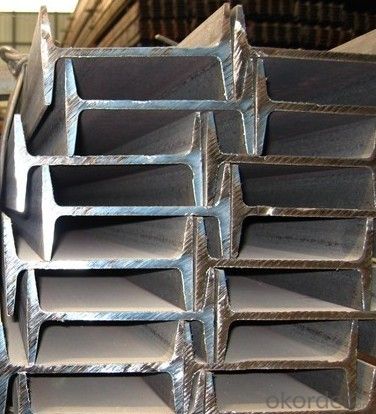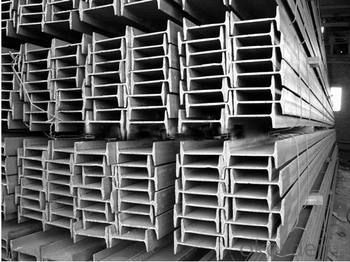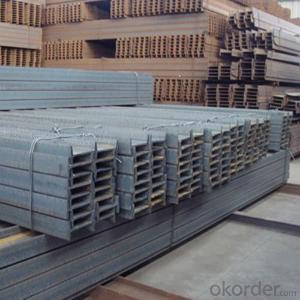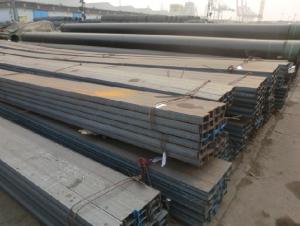80*46mm IPEAA200 ASTM A36 for construction
- Loading Port:
- Tianjin
- Payment Terms:
- TT or LC
- Min Order Qty:
- 25 m.t.
- Supply Capability:
- 100000 m.t./month
OKorder Service Pledge
OKorder Financial Service
You Might Also Like
1. Structure of Steel I Beam IPE Description:
Steel I beam IPE is a beam with an I-shaped cross-section. The horizontal elements of the "I" are known as flanges, while the vertical element is termed the "web". Steel I beam IPE is usually made of structural steel and is used in construction and civil engineering. The Steel I beam IPE resists shear forces, while the flanges resist most of the bending moment experienced by the beam. Steel I beam IPE theory shows that the I-shaped section is a very efficient form for carrying both bending and shears loads in the plane of the web.
2. Main Features of Steel I Beam IPE:
• Grade: Q235
• Type: Mild carbon steel
• Deflection: The stiffness of the I-beam will be chosen to minimize deformation
• Vibration: The stiffness and mass are chosen to prevent unacceptable vibrations, particularly in settings sensitive to vibrations, such as offices and libraries.
• Local yield: Caused by concentrated loads, such as at the beam's point of support.
1. Structure of Steel I Beam IPE Description:
Steel I beam IPE is a beam with an I-shaped cross-section. The horizontal elements of the "I" are known as flanges, while the vertical element is termed the "web". Steel I beam IPE is usually made of structural steel and is used in construction and civil engineering. The Steel I beam IPE resists shear forces, while the flanges resist most of the bending moment experienced by the beam. Steel I beam IPE theory shows that the I-shaped section is a very efficient form for carrying both bending and shears loads in the plane of the web.
2. Main Features of Steel I Beam IPE:
• Grade: Q235
• Type: Mild carbon steel
• Deflection: The stiffness of the I-beam will be chosen to minimize deformation
• Vibration: The stiffness and mass are chosen to prevent unacceptable vibrations, particularly in settings sensitive to vibrations, such as offices and libraries.
• Local yield: Caused by concentrated loads, such as at the beam's point of support.
Package & Delivery of IPE Beam
1. Packing: it is nude packed in bundles by steel wire rod
2. Bundle weight: not more than 3.5MT for bulk vessel; less than 3 MT for container load
3. Marks: Color marking: There will be color marking on both end of the bundle for the cargo delivered by bulk vessel. That makes it easily to distinguish at the destination port.
4. Tag mark: there will be tag mark tied up on the bundles. The information usually including supplier logo and name, product name, made in China, shipping marks and other information request by the customer.
If loading by container the marking is not needed, but we will prepare it as customer request.
5. Transportation: the goods are delivered by truck from mill to loading port, the maximum quantity can be loaded is around 40MTs by each truck. If the order quantity cannot reach the full truck loaded, the transportation cost per ton will be little higher than full load.
6. Delivery of IPE Beam: 30 days after getting L/C Original at sight or T/T in advance



- Q:Can steel I-beams be used for mezzanines or elevated platforms?
- Yes, steel I-beams can definitely be used for mezzanines or elevated platforms. Steel I-beams are commonly used in construction due to their strength and durability. They can support heavy loads and provide a stable structure for creating additional floor space, such as mezzanines or elevated platforms. Steel I-beams are also versatile and can be easily customized to fit specific design requirements. Additionally, steel I-beams offer long-term reliability and require minimal maintenance, making them an ideal choice for constructing mezzanines or elevated platforms.
- Q:Can steel I-beams be used in residential basement or foundation renovations?
- Residential basement or foundation renovations can incorporate steel I-beams, which are frequently utilized in construction and renovation endeavors due to their robustness and endurance. These beams offer support to the foundation and aid in distributing the load from upper levels of the structure. They are commonly employed to fortify or substitute existing basement walls or support columns, thereby enhancing the overall stability and structural integrity of the building. Furthermore, their slender design allows for more usable space in the basement compared to alternative support systems. However, it is crucial to seek advice from a structural engineer or qualified professional who can evaluate the specific requirements of your renovation project and determine the suitable size and placement of the steel I-beams.
- Q:Are there any limitations to the length of steel I-beams?
- The length of steel I-beams is subject to certain limitations. These limitations arise from factors such as manufacturing capabilities, transportation logistics, and structural considerations. Manufacturing capabilities are a significant factor in determining the size and length of steel I-beams that can be produced. Steel mills and fabrication facilities have specific equipment and processes that may impose restrictions on the maximum length that can be efficiently and cost-effectively manufactured. Transportation logistics also play a vital role in limiting the length of steel I-beams. The size and weight of longer beams can pose challenges during transportation from the manufacturing facility to the construction site. Road and bridge weight restrictions, transportation infrastructure limitations, and the availability of specialized equipment for handling and transporting long beams can further restrict their length. Structural considerations are another important limitation. Longer steel I-beams have a higher risk of deflection or bending under load. Beyond a certain length, the structural integrity of the beam may be compromised, posing potential safety concerns. Structural engineers and architects must carefully analyze the load-bearing requirements of a project and determine the maximum allowable length for steel I-beams based on factors such as load distribution, beam design, and support systems. In conclusion, while steel I-beams can be manufactured in various lengths, there are limitations imposed by manufacturing capabilities, transportation logistics, and structural considerations. It is crucial to collaborate with industry professionals to ensure that the length of steel I-beams used in construction projects adheres to these limitations while meeting the necessary design standards and safety regulations.
- Q:Can steel I-beams be used in mezzanine floor construction?
- Absolutely, steel I-beams are a viable option for constructing mezzanine floors. Their exceptional strength, durability, and capacity to handle hefty loads make them exceedingly common in the construction industry. When it comes to mezzanine floor construction, I-beams can serve as the primary structural components, providing crucial support for the floor and any additional weight. The installation of these I-beams can be done either horizontally or vertically, depending on the unique design and requirements of the mezzanine floor. Furthermore, steel I-beams lend themselves well to easy fabrication and customization, enabling them to effectively meet the specific needs of any given project. It is no wonder, then, that they are a highly favored choice in the realm of mezzanine floor construction.
- Q:Can steel I-beams be used in convention centers or exhibition halls?
- Yes, steel I-beams can be used in convention centers or exhibition halls. Steel I-beams are commonly used in construction due to their strength and load-bearing capabilities, making them suitable for large spaces like convention centers and exhibition halls that require structural support.
- Q:Does the welding of I-beam affect its structure after welding?
- Any steel after welding has an impact on its structure, only to see what the purpose.
- Q:How do steel I-beams distribute loads?
- Steel I-beams distribute loads by transferring the weight or force applied to them to the vertical support columns or walls on either end of the beam. The flanges (horizontal top and bottom sections) of the I-beam resist bending, while the web (vertical middle section) resists shear stress. This design allows the I-beam to efficiently distribute and transfer loads along its length, making it a common choice for structural support in buildings and bridges.
- Q:Are steel I-beams suitable for both residential and commercial construction?
- Yes, steel I-beams are suitable for both residential and commercial construction. Their strong and durable nature makes them ideal for supporting heavy loads and providing structural integrity in various building types. Additionally, steel I-beams offer versatility, as they can be customized to meet specific design requirements and are available in a range of sizes and shapes.
- Q:How do steel I-beams perform in terms of wind resistance?
- I-beams made of steel have a reputation for their exceptional performance when it comes to resisting wind. The structural design of the I-beam, featuring flanges and webs, provides incredible strength and rigidity, making it highly resistant to the forces exerted by wind. The shape of the I-beam allows for the efficient distribution of the wind load, minimizing the possibility of failure or damage. The flanges of the I-beam are specifically crafted to withstand bending and torsional forces caused by wind, while the web helps maintain the overall stability and stiffness of the beam. This combination of design elements ensures that the I-beam can endure high wind speeds and turbulent conditions. Furthermore, steel itself is an extremely durable and robust material, which further enhances the wind resistance of I-beams. Steel possesses a high tensile strength and elasticity, enabling it to effectively absorb and distribute the wind load. Additionally, steel is not prone to rot, warping, or decay, unlike certain other building materials, guaranteeing long-lasting durability and performance even in harsh weather conditions. All in all, steel I-beams are widely acknowledged as one of the most dependable and efficient choices for withstanding wind forces. Their structural design, coupled with the strength and durability of steel, make them the preferred option in construction projects that require sturdy wind resistance.
- Q:Can steel I-beams be used for industrial platforms or catwalks?
- Yes, steel I-beams can certainly be used for industrial platforms or catwalks. Steel I-beams are known for their strength and durability, making them an excellent choice for such applications. They are capable of supporting heavy loads and can withstand the constant foot traffic and other industrial activities typically seen on platforms or catwalks. Additionally, steel I-beams can be easily customized to meet specific design and structural requirements, allowing for efficient and safe construction of industrial platforms or catwalks.
1. Manufacturer Overview |
|
|---|---|
| Location | |
| Year Established | |
| Annual Output Value | |
| Main Markets | |
| Company Certifications | |
2. Manufacturer Certificates |
|
|---|---|
| a) Certification Name | |
| Range | |
| Reference | |
| Validity Period | |
3. Manufacturer Capability |
|
|---|---|
| a)Trade Capacity | |
| Nearest Port | |
| Export Percentage | |
| No.of Employees in Trade Department | |
| Language Spoken: | |
| b)Factory Information | |
| Factory Size: | |
| No. of Production Lines | |
| Contract Manufacturing | |
| Product Price Range | |
Send your message to us
80*46mm IPEAA200 ASTM A36 for construction
- Loading Port:
- Tianjin
- Payment Terms:
- TT or LC
- Min Order Qty:
- 25 m.t.
- Supply Capability:
- 100000 m.t./month
OKorder Service Pledge
OKorder Financial Service
Similar products
New products
Hot products
Related keywords































